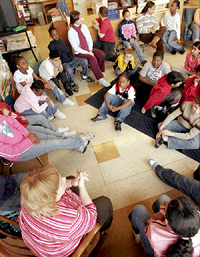How to Teach Character in the Classroom
This school’s Community Circle builds much more than a sense of community.

This how-to article is accompanied by the feature "Vital Signs: Learning Is Alive and Well at Faubion Elementary."
Mary Harbolt and Gayle Quigley have made life-skills education a staple of their team-taught fourth-grade classroom at Faubion Elementary School, in Portland, Oregon. Responsibility, initiative, friendship, sense of humor, and other skills feature in lessons covering a wide variety of topics. In Community Circle, children and teachers talk about each other's successes and shortcomings, and issue one another compliments for good behavior and challenges to do better. Here, Harbolt explains why the program packs more punch than the standard school campaign for kindness and respect.
Why should schools get involved in teaching character? Shouldn't those lessons come from home?
It has to do with classroom management. When you build community, you need to teach students about themselves, about the kind of person they want to be. Then you have fewer management problems, and you can teach the curriculum better.
How do you reinforce those skills in the classroom?
We reinforce them whenever we're reading about characters in books, people we're studying in social studies, events that have taken place, current events. We ask, "Do you think they were missing a life skill?" or "What life skill do you think they used?" We even talked about it when they raised gas prices: "How does that affect people, and what life skills do you need when things get more expensive?" It applies to everything.
What are the essential things you do to get the character lessons to sink in?
We use students' real-life experiences. We start with what's most important to them, and that's recess. The very first day of school, right after recess, we come in and we have a Community Circle, and we talk about what went well at recess and what went wrong.
How do you make the character skills relevant to their schoolwork, not just the playground?
Slowly, recess improves as the kids practice modeling life skills. Then we pick a character with trials and tribulations and talk about their life skills. Then we transition to life skills in the classroom: "Oh, I really like how Table 1 is modeling cooperation." We emphasize the positive. It starts with recess, then it moves into the classroom, it spreads into the rest of the school, and eventually we make a home connection as well.
How do you facilitate the children's use of the skills at home, especially if the skills are not reinforced there?
We usually tie that in with New Year's resolutions, so that doesn't happen until January. We talk about a resolution for school, and then we say, "Let's make one at home," and Gayle and I do it, too. We model the skills in our own lives for the students. We try to make sure the parents are aware that this is happening, and we try to steer kids toward things we feel a parent would appreciate and compliment.
What strategies do you use to make children comfortable discussing their areas of weakness?
When they complain about something at recess, we don't name names in the beginning. We just talk about the incident. When we make the transition to talk about people, we have already done it with characters in books. Then we pick an incident that was a simple incident to solve, and we add a name. It's a gentle transition, and it has worked every year.
How do you find time to do this while you're trying to cover all the academic content?
The Community Circle builds cohesiveness. It diminishes tattling, because the kids can wait till Community Circle to talk about something, and in the long run it saves our time. If you have kids who believe in themselves and set goals for themselves, you've cut way down on behavior problems, and then you spend more time teaching.
When it comes to life skills, where do you draw the line between teaching and preaching?
The students help us draw the line. They want to do the talking, they want to do the sharing, they want to analyze the life skills. Once you get them talking about life skills, it's very much hands off; it's just me facilitating a Community Circle, so I would say they keep me from preaching.